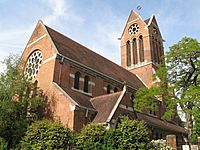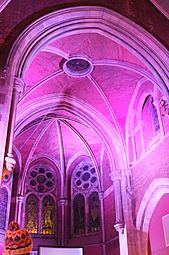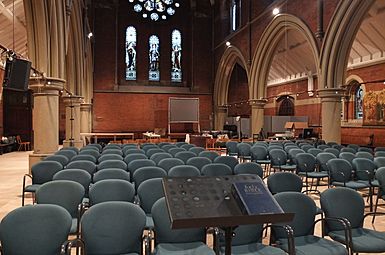St Luke's Church, Kentish Town facts for kids
Quick facts for kids St Luke's Kentish Town |
|
|---|---|
| St Luke's Kentish Town | |

The nave and tower of St Luke's Kentish Town
|
|
| Lua error in Module:Location_map at line 420: attempt to index field 'wikibase' (a nil value). | |
| OS grid reference | TQ 295 850 |
| Location | Kentish Town, London NW5 2AT |
| Country | England |
| Denomination | Anglican |
| History | |
| Founded | 1867 |
| Dedication | Saint Luke |
| Dedicated | 1867 |
| Consecrated | 1869 |
| Architecture | |
| Heritage designation | Grade II* |
| Designated | 10 June 1954 |
| Architect(s) | Basil Champneys HMDW Architects |
| Architectural type | Church |
| Style | Victorian |
| Groundbreaking | 1867 |
| Completed | 1869 |
| Specifications | |
| Spire height | 40 metres (131.2 ft) |
| Materials | Red brick with stone dressings, red tile roof |
St Luke's Kentish Town is a busy Church of England parish church located on Oseney Crescent in Kentish Town, North London. This church was closed for a long time, from 1991 to 2011. It is now home to a new church community started by Holy Trinity Brompton Church. The building is very important and has been given a special status as a Grade II* listed building by English Heritage. This means it's a historic place that needs to be protected.
Contents
History of St Luke's Church
Building the Church (1867-1869)
St Luke's Church was built between 1867 and 1869. The money for its construction came from an interesting source. A railway company paid £12,500 because they had to demolish an older church, St Luke's Church, Euston Road. Money from selling the old church building also helped.
An architect named John Johnson had built the original church. He hoped to design the new one in Kentish Town. However, a young architect named Basil Champneys, who was only 25 years old, was chosen instead. This was one of Champneys' very first buildings and his first church design. His father, William Weldon Champneys, was the vicar of the nearby St Pancras parish and helped commission the church.
Art and Features Inside the Church
During the first building phase, beautiful stained glass windows were added. These three windows in the east were designed by Henry Holiday and made by a company called Heaton, Butler and Bayne. This same company also created the aisle windows, which show the twelve apostles, around 1880-1890. They also made the large west window in 1891.
In 1893, a Willis organ was installed, which is a large musical instrument. Later, in 1910, four more stained glass windows were added to the south clerestory by Morris & Co.. Two of these windows feature designs by Edward Burne-Jones, and two others by John Henry Dearle.
Changes Over Time
In the 1930s, a reredos (a decorative screen behind the altar) was added. In 1955, St Luke's joined with St Paul's Camden Square, but this arrangement ended in 1987. The church's current brass eagle lectern (a stand for reading) dates back to 1882. It originally came from St Paul's, which had been damaged during a war.
The church building closed its doors in 1991. It was then looked after by the Churches Conservation Trust, an organization that helps preserve historic churches.
Reopening and Renovation
In 2011, St Luke's Church reopened its doors. This happened through a special church decision that named the Reverend Jonathan March as the new parish priest. Renovation work was completed in January 2012, and church services started again on January 29, 2012.
Architecture of St Luke's
Outside the Church
The outside of St Luke's Church is mostly made of red brick with stone details. The roof is covered with red tiles. The church tower has a unique saddleback gabled roof, which means it looks like a saddle. This style is similar to North German architecture. The tower has three arched openings for the belfry (where the bells are) and decorative stone patterns above. The rest of the church, including the nave, chancel, and aisles, shows details from the Early English revival style.
The main part of the church, the nave, has four sections with narrow aisles on the sides. The chancel, which is the area around the altar, is located under the tower. It has a rounded end with decorative stone patterns. The west end of the church has three tall, narrow windows called lancet windows. Above them is a round window with a pattern, known as a rose window. The aisles and the upper part of the walls (clerestory) have pointed windows arranged in pairs.
Inside the Church
Inside, the walls are made of exposed red brick with two bands of stone running across them. The main arches in the nave have short, round pillars. Between these arches, there are shafts that help support the main wooden beams of the roof. The floor is covered with red and black tiles.
From the central area, there are three steps leading up to the chancel, which has a brick-vaulted ceiling. There are six more steps up to the sanctuary, the most sacred part of the church. This area has decorative tiles and special seats called sedilia.
Gallery
See also
- HTB network




